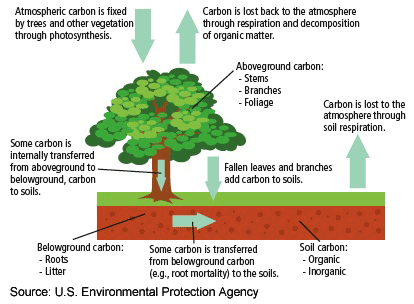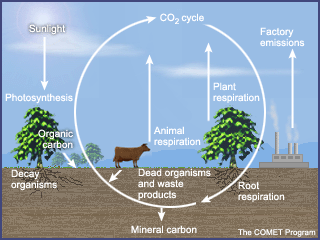Reforestation & Afforestation
DEFINITION & TYPES OF STRATEGIES
Coolymplanet proposes reforestation and afforestation as two good solutions to combat climate change. It is important to increase carbon sequestration by means of reforestation (or afforestation) since it helps to mitigate global warming by slowing the growth of carbon emissions to the atmosphere. It is a fact that before the Industrial Revolution atmospheric CO2 concentrations were much lower than currently. The main sources of fluctuation in atmospheric levels of carbon were changes in biomass and soil organic carbon.Humans, by means of deforestation and burning fossil fuels have altered this carbon equilibrium.
Carbon terrestrial sequestration can be used to reduce GHG emissions.Experience is demonstrating that establishing new forests can offer cost-effective management options for offsetting carbon emissions.Reforestation is the establishment of trees on land that has been deforested within the relatively recent past or has just been harvested. Reforestation is the conversion of land use back to forest after a period of some other land use. The IPCC defines reforestation as: “the planting of forests on lands which have, historically, previously contained forests but which have been converted to some other use.
Reforestation then, is a direct human-induced activity that involves a change in the land use.Reforestation can be used to enhance the quality of human life by absorbing and capturing CO2 and other damaging particles. It also can take part in Ecosystem Restoration and it can mitigate global warming by means of biosequestration of CO2. An important fact is that reforestation helps to harvest resources, as the timber. The difference between reforestation and afforestation is that while reforestation is the reestablishment of forest cover, afforestation is the establishment of trees in an area where there was no forest.
HOW TREES CAPTURE CO2?
Trees are able to concentrate and store carbon. Through photosynthesis, trees absorb CO2 from the atmosphere and convert it into carbohydrates and oxygen. These carbohydrates, including glucose, are used to build cellulose and lignin, the main constituents of the wood of branches and barks of the trees. The generated carbon by means of photosynthesis remains stored for the life of the wood product but when a tree or wood product is burnt, the carbon returns to the atmosphere trough Carbon Cycle.


PHOTOSYNTHESIS PROCESS
Photosynthesis is a process in which plants (and other organisms) convert sunlight into chemical energy. This chemical energy is stored in carbohydrate molecules (such as sugars) which are synthesized from carbon dioxide and water.
First, sunlight is absorbed by proteins that contain green chlorophyll pigments. These proteins are held inside organelles called chloroplasts. Reactions are light-dependent and some energy is used to strip electronsfrom substances such as water, producing oxygen. Furthermore, two extra compounds are generated: NADPH and ATP (the energy of cells) Sugars are produced by light-independent reactions known as the Calvin cycle. In the Calvin cycle, atmospheric CO2 is incorporated into an already existing organic carbon compound, (the ribulose bisphosphate).
CO2 SEQUESTRATION
Numerous scientists have estimated that afforestation and reforestation could achieve annual carbon sequestration rates in biomass of 0.4-1.2t/hayr in boreal regions, 1.5-4.5 t/hayr in temperate regions, and 4-8 t/hayr in tropical regions. There is 0.3 tC/m3 of wood in boreal and temperate regions and 0.4 tC/m3 wood in tropical regions.
The map above shows the global forest loss (red), forest extent (green), forest gain (blue) and both lost and gain (pink). Research shows tropical forest loss is increasing overall by 2,100 sqkm per year. Earth lost a total of 2.3 million square kilometers of tree cover in 10 years.

Benefits to the Environment
Forests are important because they take part in the carbon cycle trough photosynthesis. Both, reforestation and afforestation can be two similar ways to combat climate change since they are able to remove CO2 from the air. Once they have picked up the atmospheric CO2, they store it for a long time. Forests remove around three billion tons of anthropogenic carbon every year (30% of all carbon dioxide emissions from fossil fuels).
How can reforestation help to the environment?
- Increasing the amount of forested land
- Increasing the carbon density of existing forests
- Expanding the use of forest products that will sustainably replace fossil-fuel emissions
- Reducing carbon emissions that are caused from deforestation and degradation
The amount of captured and stored carbon depends on multiple factors:
- Not all the species capture the same amount of Carbone
- One plant may grow quickly than other (i.e a genetically modified tree specimen that grows much faster than a slow-growing tree)
- The reforestation (or afforestation) site is also very important.
Trends
According to IPCC the maximum amount of carbon that might be sequestered by global afforestation and reforestation activities for the period 1995-2050 was estimated at 60-87 Gt C (70% in tropical forests, 25 % in temperate forests, and 5% in boreal forests). The issue most important is to decrease the rate of deforestation: there are 13 billion meters squared of tropical regions that are deforested every year. There is potential for these regions to reduce rates of deforestation by 50% by 2050, which would be a huge contribution to mitigate the global warming.
